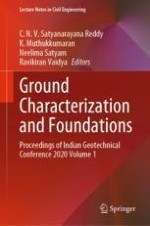2022 | Book
Ground Characterization and Foundations
Proceedings of Indian Geotechnical Conference 2020 Volume 1
Editors: Prof. Dr. C. N. V. Satyanarayana Reddy, Dr. K. Muthukkumaran, Dr. Neelima Satyam, Dr. Ravikiran Vaidya
Publisher: Springer Singapore
Book Series : Lecture Notes in Civil Engineering
